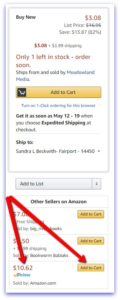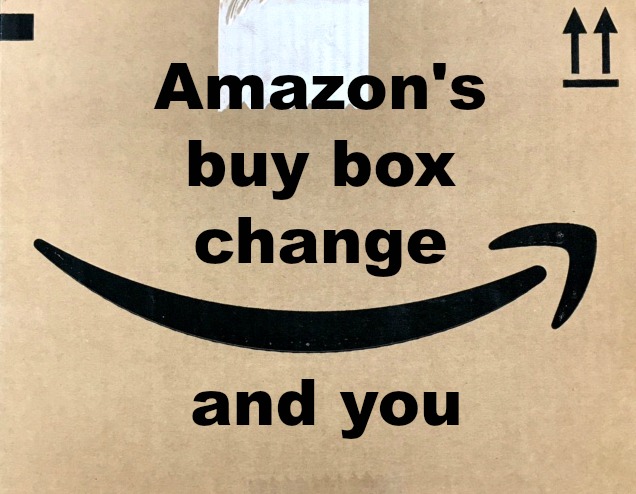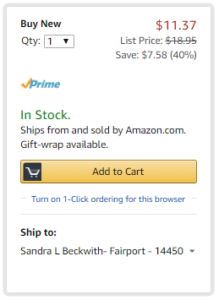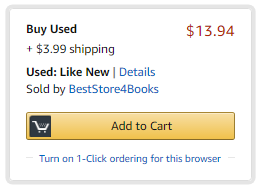Amazon’s buy box change and you
You might have heard about Amazon’s buy box change by now.
If you haven’t, here’s the summary: The default purchase option in what is known as the “buy box” used to be the book’s publisher (either the publishing company or you, the author, if you’re self-published). That’s no longer guaranteed.
With the change, a third-party vendor, not the publisher, might “own” the buy box. This is how Amazon sells other products; it’s now applying that process to print books.
There are several articles about this online, but I found this one from Vox.com, “Amazon made a small change to the way it sells books. Publishers are terrified,” especially helpful.
The Amazon buy box
Here’s what the buy box looks like.
This one is for Neil deGrasse Tyson’s best-selling Astrophysics for People in a Hurry. In this case, the publisher owns the buy box. We know that because the box says “Ships from and sold by Amazon.com.”
Before the policy change, that’s what your book’s print buy box said — “Ships from and sold by Amazon.com.” Maybe it still does. But maybe it doesn’t.
Now, a third-party vendor might own the buy box for your book or anyone else’s book, for that matter.
How does that happen?
Amazon applies the magic of its mysterious algorithms that take into account the usual factors Amazon uses to award that spot to vendors of other products — low price, high customer rating, and Amazon Prime availability, for starters. It’s a competition to be the featured offer.
What does this look like now?
 Here’s what the buy box for Cami Ostman’s memoir, Second Wind: One Woman’s Midlife Quest to Run Seven Marathons on Seven Continents
Here’s what the buy box for Cami Ostman’s memoir, Second Wind: One Woman’s Midlife Quest to Run Seven Marathons on Seven Continents, looked like recently.
With Amazon’s buy box change, to buy the book from the publisher — as indicated by “Prime/Sold by Amazon.com” — the customer has to:
- Want to do that
- Know what to look for
- Scroll down to find it
Will Amazon shoppers do that?
Most don’t even know about this change. They’re used to buying directly from the publisher with books — will they notice even a slight change in that now?
If they notice that the buy box option looks different, will they scroll down to see the other options?
More importantly will they even care?
Those who want the lowest price possible will like this change. Others probably won’t even notice a difference.
What does Amazon’s buy box change mean for authors?
There’s a lot of speculation, but nobody’s really certain yet what Amazon’s buy box change means for authors. It’s hard to hard to know what’s fact and what isn’t.
For example, Publishers Weekly reports that third-party vendors that win the buy box must be selling new books (see “Update” at the end of the article at that link) and that it gives preference to Prime selling accounts. Yet, as I’m writing this, the buy box for the paperback version of Sheryl Sandberg’s Option B offers used books — not new — with a $3.99 shipping charge — not free shipping with Prime.
Hmmm . . . .
So what do we know for sure?
1. You might have already been paid for those books sold in the buy box.
The third-party vendors might have purchased them at a discount from a number of legitimate sources. If that’s the case, you have been credited with the appropriate royalty.
2. You might not make any money from those books sold in the buy box.
If some of the new books available from outside vendors were review copies, for example, you won’t be paid for them.
3. You should encourage all book buyers — not just your readers — to look for the “Prime/Sold by Amazon.com” purchase option.
This is the only way they can be certain that the book they’re buying is new. And, it’s the only way you’ll be certain that you’ll earn royalties from sales.
Think about it: If you’ve already been paid for the book sold in the buy box — or you’re not going to be paid because of the way the vendor acquired it — you’re not going to make any more money on buy box books. To continue to earn royalties, you need people to buy directly from the publisher, whether that’s a big-name outfit like St. Martin’s Press or your own imprint.
The more people know to look for and buy from the “Prime/Sold by Amazon.com” purchase option, the more money you’ll make on Amazon.
4. Some people will always buy the lowest price product.
They don’t care if the book is new, like new, or used. They just want the lowest price.
Those buyers hunted for the best price before this buy box change made it easier for them to find it. You’ll never escape that.
5. As individuals, self-published authors have no clout with Amazon.
A common reaction among self-published authors to this and other Amazon practices they consider frustrating is, “This isn’t fair! We need to change this!”
Good luck with that.
Large publishers might be successful winning back the buy button through negotiation or the natural flow of things, but individuals won’t get anywhere protesting. Amazon is in business to make money, not keep self-published authors happy.
6. If you offer printed books on Amazon, use CreateSpace to publish them.
As reported by this article on the Independent Book Publishers of America site, “Amazon suggests that one of the ways you can win the Buy Box is to keep books ‘in stock.’ ”
That could be code for “print with CreateSpace.”
We’ve long known from anecdotal information that Amazon seems to give preference to print-on-demand — POD — books printed through CreateSpace. Those books aren’t plagued by “out of stock” messages that you see for books that are mysteriously in stock but not showing up that way on the site. (For more on this strategy, read “Why you need both CreateSpace and IngramSpark” on this site.)
Where does this leave you?
This change is not, as some have suggested, a reason to pull your printed book from Amazon. That site sells most books purchased online, so leaving it would hurt you and your book, not Amazon.
But it is a reason to make sure it’s available at other online retailers, including Barnes & Noble and IndieBound.com.
Is it frustrating? Yes. Should you lose sleep over it? No.
Put your energy into writing and packaging the best book possible. That’s the only piece of this that you can control.
What’s happening with your print book buy box on Amazon? Please tell us in a comment.
Whether you sell print or e-books on Amazon, be sure to make the most of your sales page on that site, Learn how to do it in our affordable video training program, “How to Sell More Book on Amazon.”
Like what you’re reading? Get it delivered to your inbox every week by subscribing to the free Build Book Buzz newsletter. You’ll also get my free “Top 5 Free Book Promotion Resources” cheat sheet immediately!




Thanks, Sandra. I noticed this a few days ago.
As a frequent Amazon buyer, I always choose products shipped by the Zon. I’ve had less than stellar experiences with a few third-party vendors. A few months ago I had one of my print books show up under multiple ASINs. A quick e-mail to Support placed them all on my main author page.
Now I see “More Buying Choices” as an option under several of my books, and some of the prices are higher than retail.
Kathy, I use Amazon a lot, too, and as a Prime member, I look for that “Prime” option for the “free” shipping that I’ve already paid for with my membership (so it isn’t exactly “free,” eh?).
I often give books as gifts and would be mortified if the book I had shipped to the recipient turned out to be used. For that reason alone, buying from the publisher makes good sense.
As for the higher prices under “more buying choices,” that’s validation that the buy box should go to a lower priced option.
Thanks for the feedback!
Sandy
Great article, Sandy. I will share this with my email list and on all of my social media as my clients are worried about this change and there is a bit of hysteria around this.
I was going to write an article on this myself but I won’t need to now. 🙂
Thanks, Peter. I’m so glad you’ll share it — we can help more authors that way. I agree with you on the hysteria — I thought the IBPA article fueled that unnecessarily, but I linked to it because of the tip for using CreateSpace.
Honestly, I think this will have the biggest impact on traditionally published books — they are more likely to be in the pipelines that supply the third-party vendors.
Thanks for weighing in!
Sandy
Hi Sandy! Thank you for the reply. I am prepping an email to my list right now.
My thoughts exactly re: traditional publishers!
I really don’t think that self-publishers have anything to worry about. I have been telling my clients for a long time (as you advise as well) that they should be using Ingram Spark and Createspace together anyway. I have linked them to your article on that as well.
Thanks again!
And yet, Peter, self-pubbed authors are probably more concerned than traditionally pubbed authors because the latter usually receive an advance to write the books, so they’re paid before the book goes on the market AND they don’t fund book production. Everything with self-publishing comes out of pocket, so every penny lost hurts more. (Sigh.)
Thanks for sharing — the article, and your thoughts!
Sandy
Very true, Sandy.
To put it another way, I suppose, it is the traditional publishers who stand to lose the most in the long run. Interesting times ahead.
Thanks, Sandy. This could be a confusing issue to writers. Your article is clear and straightforward. Much needed.
Gary
Thank you, Gary. I’m glad it was helpful. This seems like a “let’s wait and see what happens” situation.
Sandy
Very helpful article, Sandy. Thank you. My books are still listed first with Amazon/Prime. They’re printed by CS and Ingram (not Spark). I’m working on a new one which will likely be produced elsewhere because of my binding choice, perhaps through a traditional publishing house. It will be interesting to see what happens with it.
Will share the article with my Amazon seller writing colleagues.
Katy
I’m glad it was helpful, Katy! I suspect that this will impact traditionally published authors more than it does self-published authors, but it’s too soon to know. Good luck with the next one!
Sandy
Hi Sandra,
Thanks for explaining this and breaking it down to simple terms and actions. The world if publishing is certainly crazy, but you gotta do what you gotta do.
Always great info to act on!
I’m glad it was helpful, Carol! Back in the day, the publishing world and rules didn’t change much. Now, the one thing you can count on is change!
Sandy
I appreciate the info you gave for the change by Amazon in recent the way she sells books for authors online.
Hi Sandra,
Excellent article on the change in the Buy Box. I publish all my print books through CreateSpace, and it makes me wonder about their Extended Distribution selection? I use it sparingly, even though it is free. It does have a draw back when you select it you get a lower royalty rate, which means your break even point is raised. As a result, you have to increase the price of your book significantly to make the same profit. When you have a good selling book and the extended distribution dealers order it you are paid less for their purchases. So I wonder if they will also be allowed to take over your Buy Button and under cut you on amazon, too?
That seems possible, Joe. It makes sense!
Sandy
Luckily, my book on amazon is an eBook and not affected by this (I checked). But I’m still considering removing it and moving it over to Lulu, where my printed book is..I like them better and have less issues than with Amazon. May remove Amazon access of my printed book – high distribution fees and low royalties, among other things. But this is good to know and I will monitor my page more often. Thanks!
Denis, this change only applies to printed books. Before you remove your e-book from Amazon, you’ll want to consider that most books purchased online are purchased on Amazon. You can offer it on both Amazon and Lulu simultaneously, too — why not try that?
Sandy